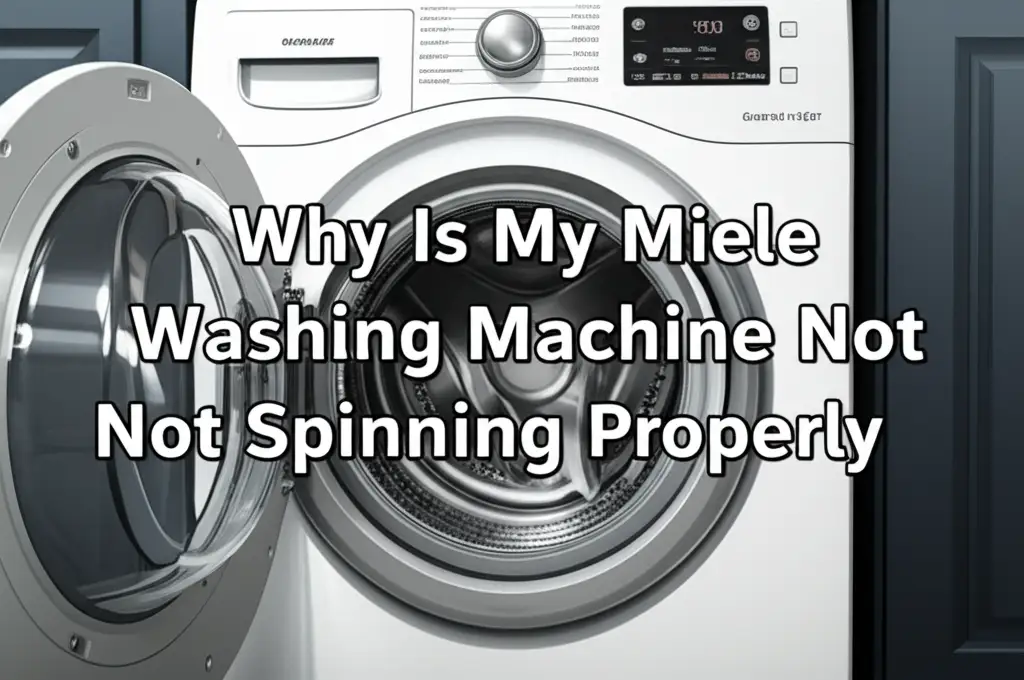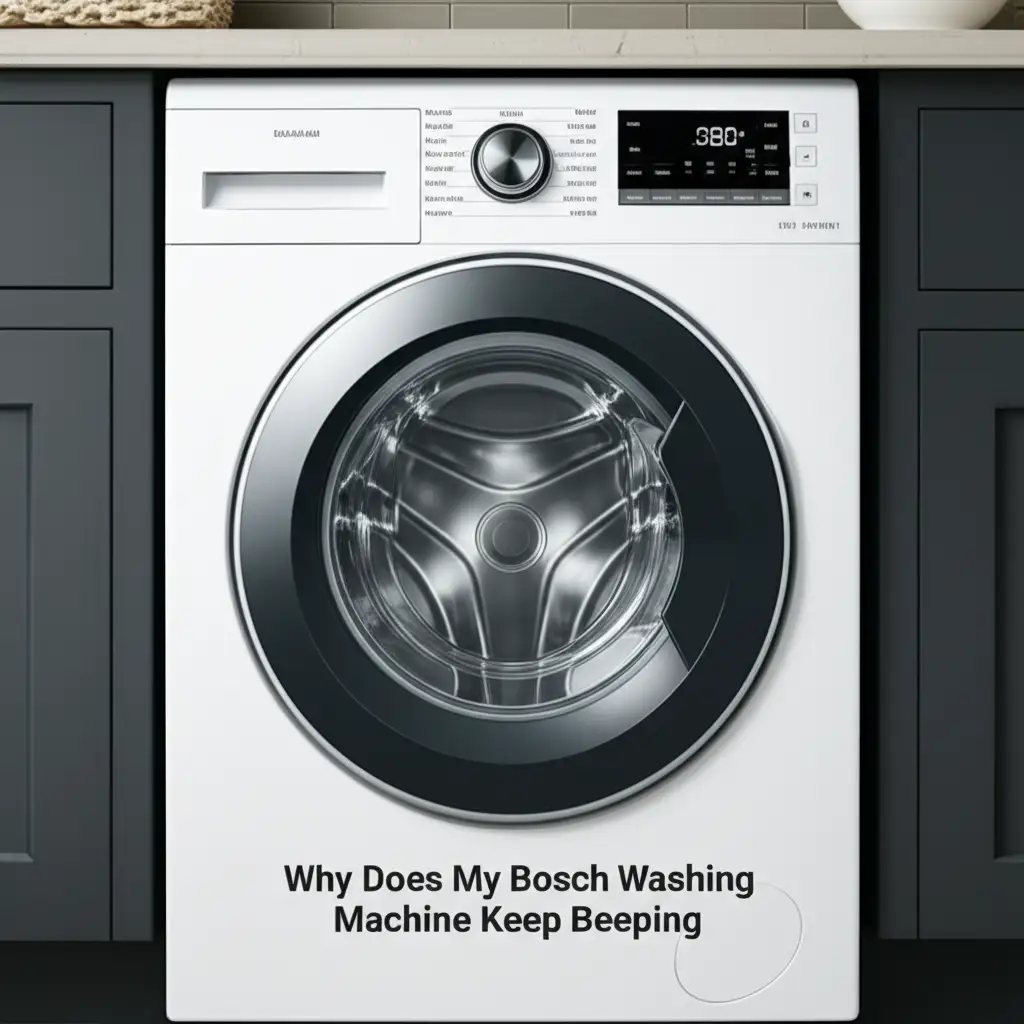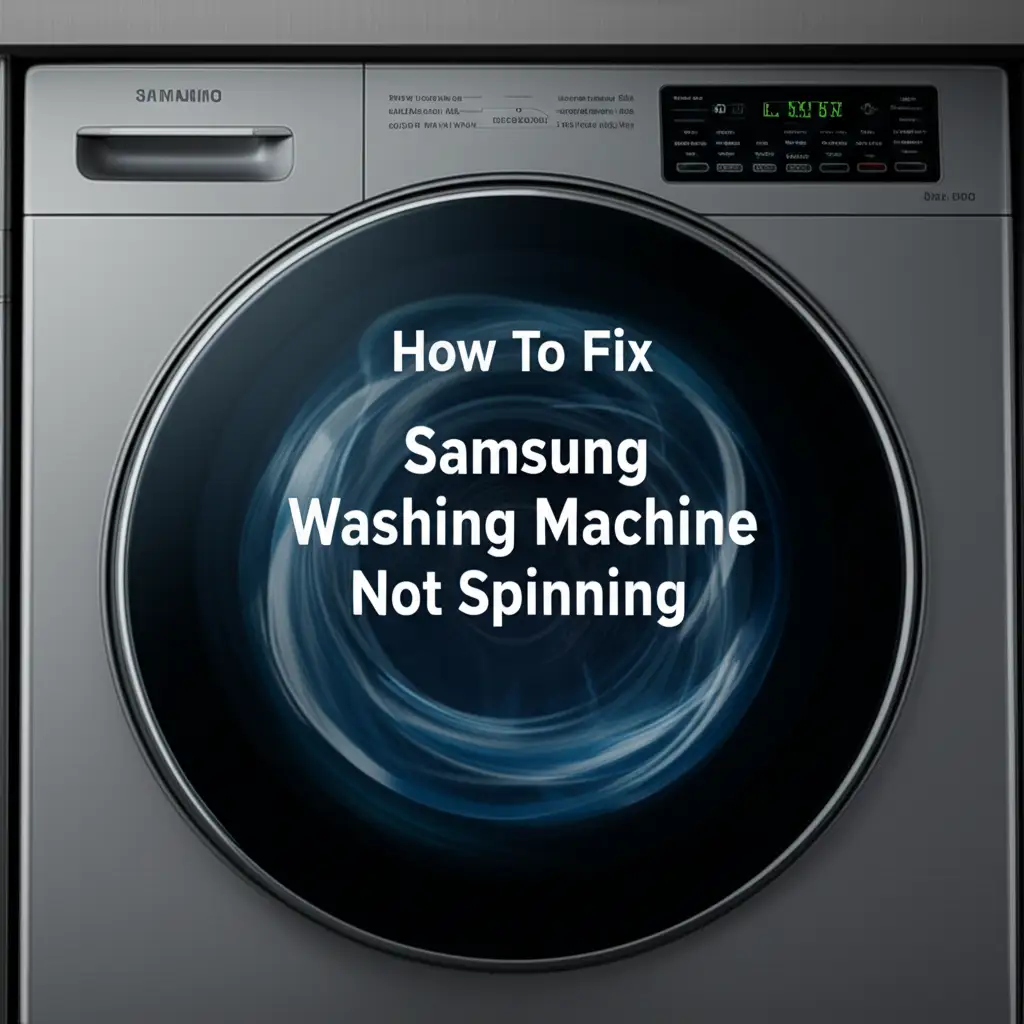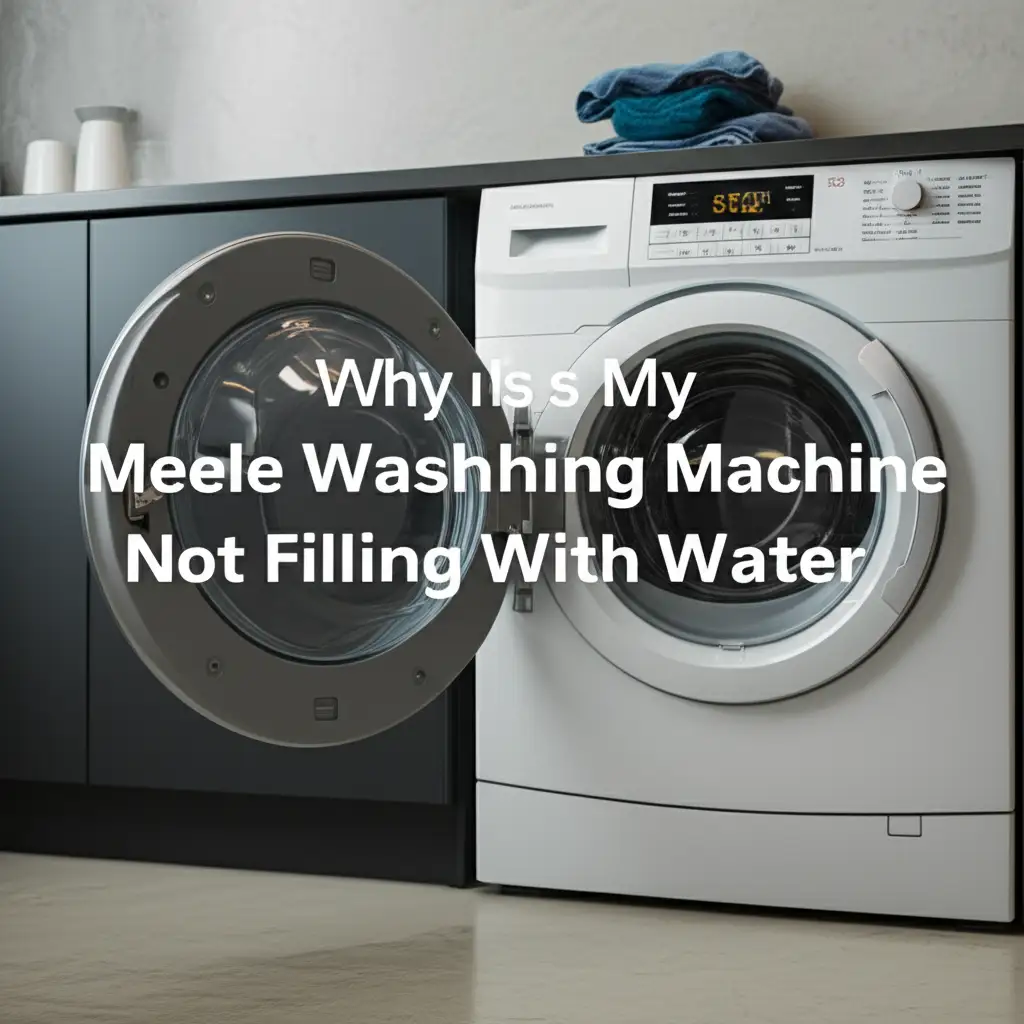· Katria Melrose · Miele Appliance Repair · 19 min read
Why Is My Miele Washing Machine Not Spinning Properly

Why Your Miele Washing Machine Isn’t Spinning Right
Imagine loading your laundry, expecting clean, nearly dry clothes, only to find them soaking wet after the cycle ends. This is a common and frustrating problem when your Miele washing machine not spinning properly. A washing machine that fails to spin makes laundry day difficult. The spin cycle is essential for removing excess water from clothes, shortening drying times, and ensuring clothes come out fresh.
I understand how vital a properly functioning washing machine is for your home. Miele appliances are known for their durability and performance, so encountering a spin issue can be puzzling. This article will help you understand the core reasons why your Miele washing machine might not be spinning properly. We will explore common culprits, guide you through troubleshooting steps, and offer practical solutions. You will learn to identify potential problems, from simple user errors to more complex mechanical or electrical faults, and decide when to seek professional help.
Takeaway
- Check Load Balance: Ensure the washing machine is not overloaded or underloaded, and clothes are evenly distributed.
- Inspect Drainage System: Clear the drain filter, check the drain hose for kinks or blockages, and listen for the drain pump.
- Verify Door Latch: Make sure the door is fully closed and latched; the machine will not spin if it detects an open door.
- Examine Drive System: Listen for unusual noises that might indicate a failing motor or a worn drive belt.
- Assess Electrical Issues: Confirm the machine has power; a lack of power can prevent any cycle from starting properly.
- Consider Sensor Malfunctions: Faulty water level sensors or pressure switches can cause spin cycle problems.
- Perform Regular Maintenance: Clean the detergent drawer and drum regularly to prevent buildup affecting performance.
Your Miele washing machine may not be spinning properly due to an unbalanced load, a clogged drain filter or hose, a faulty door latch, or issues with the motor or control board. Addressing these common problems often involves simple DIY checks and fixes.
Understanding the Miele Spin Cycle: How It Works
The spin cycle is a critical phase in your Miele washing machine’s operation. It removes most of the water from your laundry after rinsing. This process relies on the drum spinning at very high speeds, using centrifugal force to push water out through the drum’s perforations. The water then drains away through the machine’s drainage system.
For a successful spin, several components must work in harmony. The motor drives the drum, while the control board manages the speed and duration of the spin. A functioning drain pump and clear hoses are necessary to remove the water extracted during the spin. Safety features, like the door latch, ensure the machine only spins when the door is securely closed. Understanding these basic functions helps pinpoint where a problem might lie if your Miele washing machine is not spinning properly.
Addressing Overload and Unbalance: Common Spin Cycle Issues
One of the most frequent reasons a Miele washing machine fails to spin properly is an unbalanced load. Miele machines are smart; they have sensors that detect if the laundry inside the drum is unevenly distributed. If the machine detects an imbalance, it will attempt to redistribute the load by tumbling the clothes. If it cannot achieve balance, it will either spin at a reduced speed, not spin at all, or pause the cycle to prevent damage to the machine.
Overloading Your Miele
Putting too many items into your Miele washing machine can cause an overload. An overloaded drum makes it impossible for clothes to move freely and distribute evenly. This leads to an unbalanced load that the machine cannot correct.
Always check your Miele washing machine’s capacity and avoid stuffing the drum too full. Leave enough space for clothes to tumble and shift during the wash cycle. Overloading can also strain the motor and other components over time.
Uneven Load Distribution
Sometimes, even with a normal amount of laundry, certain items can clump together. Large, absorbent items like towels, sheets, or heavy jeans are common culprits. These items can absorb a lot of water and stick to one side of the drum, creating a heavy spot. This uneven distribution will trigger the machine’s unbalance detection.
To fix this, pause the cycle, open the door, and manually redistribute the laundry. Separate any tangled items and spread the load evenly around the drum. Close the door and resume the cycle. If this is a recurring problem, try washing fewer large items together in one load.
Troubleshooting Miele Drainage System Problems
For your Miele washing machine to spin effectively, it must first drain all the wash water. If the machine cannot drain water, it will not proceed to the spin cycle. This is a safety feature to prevent damage and flooding. Problems with the drainage system are a common cause of a Miele washing machine not spinning properly.
I have seen many instances where a simple blockage prevents proper drainage. This issue often links to the drain filter, the drain hose, or the drain pump itself. Ensuring these components are clear and working correctly is a key troubleshooting step. If your machine is full of water and not spinning, addressing drainage is your first priority. You can learn more about general issues with machines not draining and spinning in other guides, such as Why Is My GE Washing Machine Not Draining and Spinning.
Checking the Drain Filter
The drain filter is designed to catch lint, coins, buttons, and other small debris before they enter the drain pump. Over time, this filter can become clogged, restricting water flow. A clogged filter will prevent the machine from draining properly, thus stopping the spin cycle.
You will find the drain filter typically located at the bottom front of your Miele washing machine, behind a small access panel. Before opening it, place a shallow pan or towels underneath to catch any residual water. Carefully unscrew the filter and remove any debris you find. Clean the filter thoroughly under running water and reinsert it securely. Always consult your Miele user manual for specific instructions on accessing and cleaning the filter for your model.
Inspecting the Drain Hose
The drain hose carries water from the washing machine to your home’s drainpipe. If this hose becomes kinked, bent, or obstructed, it will impede water drainage. A kinked hose is a common oversight that is easy to fix.
Check the entire length of the drain hose from the back of the machine to the standpipe or sink it drains into. Straighten any kinks or bends. Also, ensure the hose is not pushed too far down into the drainpipe, which can create a siphon effect or block airflow needed for proper drainage. If you suspect an internal blockage, you may need to disconnect the hose and flush it out.
Drain Pump Malfunction
If the filter is clean and the hose is clear, the problem might lie with the drain pump itself. The drain pump is responsible for forcing water out of the machine. If the pump is faulty, jammed, or has an electrical issue, it cannot expel water, and the spin cycle will not engage. You might hear a humming noise but no water movement, or no sound at all from the pump.
Diagnosing a faulty drain pump can be more complex. You might need to access the pump directly, which usually involves tilting the machine or removing a rear panel. Check for any foreign objects lodged in the pump’s impeller. If the pump runs but no water drains, or if it makes unusual noises, it may need replacement. For similar issues across different brands, you can find more insights on articles like Why Is My Beko Washing Machine Not Spinning or Draining.
Investigating Door Latch and Interlock Issues
Your Miele washing machine has a crucial safety mechanism: the door latch and interlock system. This system ensures the door is securely closed and locked before the wash or spin cycle can begin. If the machine detects that the door is not properly shut, or if the interlock mechanism is faulty, it will prevent the spin cycle from starting. This is a deliberate design feature to prevent water leaks and injury.
Sometimes, the door simply isn’t pushed shut with enough force. Other times, debris might be caught in the latch mechanism, preventing it from fully engaging. A more serious issue involves a faulty door latch switch itself. This component tells the control board whether the door is locked. If the switch fails, the machine believes the door is open, even when it is physically closed.
To troubleshoot, first, ensure the door is firmly pushed closed until you hear a click. Check the area around the door latch for any obstructions like fabric or small items. If the door closes but the spin still does not activate, the latch mechanism might be defective. You can often tell if the latch is working by listening for the “click” sound when the cycle should start. If the door cannot be opened after a cycle, or if it remains locked when it should open, this also points to a latch problem. You can find more information on Miele door issues in articles such as Why Is My Miele Washing Machine Not Opening the Door. If the door latch is broken, it will require replacement. This is a common part that can wear out over time with repeated use.
Diagnosing Motor and Drive Belt Failures
The motor and drive belt are the powerhouse of your Miele washing machine. They are responsible for turning the drum during both the wash and spin cycles. If either of these components malfunctions, your Miele washing machine will struggle to spin, or it might not spin at all. Problems here are often indicated by unusual noises or a complete lack of drum movement.
Worn Drive Belt
Many Miele washing machines use a drive belt to transfer power from the motor to the drum. Over time, this belt can stretch, become loose, or even break. If the belt is loose, it might slip, preventing the drum from reaching the high speeds needed for an effective spin. If the belt breaks, the drum will not turn at all, even though you might hear the motor running.
You might hear squealing, grinding, or thumping noises if the belt is worn or slipping, particularly during acceleration. Inspecting the drive belt usually requires access to the back or bottom of the washing machine. If the belt is visibly damaged, loose, or broken, it needs to be replaced. This is a common wear-and-tear item that can be replaced by a capable DIY enthusiast or a professional. For banging noises, which can sometimes relate to a failing belt or motor, consult resources like Why Is My Miele Washing Machine Banging When Spinning.
Motor Problems
The motor is the heart of the spin cycle. A faulty motor can manifest in several ways: it might not spin the drum at all, it might spin intermittently, or it might spin very slowly. Motor issues can range from problems with the motor’s carbon brushes (if applicable to your model) to a complete motor failure.
Signs of a failing motor include a humming sound without drum movement, burning smells, or the machine trying to spin but failing. Sometimes, a thermal cut-out in the motor might activate due to overheating, causing the motor to temporarily shut down. Checking the motor usually requires more advanced disassembly of the machine. While replacing a motor can be costly, it is sometimes necessary to restore full functionality. This repair is best left to experienced technicians.
Electrical Supply and Control Board Complications
A washing machine relies heavily on a stable electrical supply and a functional control board to operate correctly. If your Miele washing machine is not spinning properly, or if it shows no signs of life, the problem could stem from electrical issues or a malfunctioning main control board. These components dictate the entire cycle, including the precise timing and speed of the spin.
Power Supply Check
First, confirm that your Miele washing machine is receiving power. Ensure the power cord is securely plugged into a working outlet. Check your home’s circuit breaker box to see if the breaker for the laundry area has tripped. If it has, reset it. Sometimes, a temporary power surge or outage can affect the machine’s electronics.
If the machine has no power, or if its display is not working, this is a clear sign of an electrical issue. Without proper power, no cycle, including the spin, can initiate. A simple power reset by unplugging the machine for a few minutes and plugging it back in can sometimes clear minor glitches. For more general troubleshooting of power issues, you can refer to articles such as Why Does My Miele Washing Machine Have No Power.
Control Board Faults
The control board, often called the Printed Circuit Board (PCB), is the brain of your Miele washing machine. It processes all commands, monitors sensors, and sends signals to components like the motor and pump. If the control board is faulty, it might send incorrect signals, or no signals at all, to the spin motor. This can result in erratic spinning, failure to spin, or error codes displayed on the machine’s panel.
Control board issues are generally complex to diagnose and repair. Symptoms can be varied, from complete machine failure to specific cycle malfunctions. A control board typically cannot be repaired and requires replacement. This is usually an expensive part and installation often requires a qualified technician due to the delicate nature of electronic components. Look for specific error codes on your Miele’s display, as these often point directly to component failures, including those related to the control board.
Examining Water Level Sensor and Pressure Switch Malfunctions
For your Miele washing machine to proceed through its cycles, it needs to know how much water is in the drum. This information is provided by the water level sensor or pressure switch. These components measure the water level and communicate it to the control board. If either of these sensors malfunctions, the machine might mistakenly believe there is still too much water in the drum, even if it has drained, or it might not allow the spin cycle to start.
The machine might fill with water but then stop without progressing to the wash or spin phases. This happens because the control board expects a signal confirming the correct water level before moving on. If the sensor is faulty, it will never send this signal, halting the cycle. Similarly, if the pressure switch (which detects water pressure in a tube connected to the drum) is blocked or defective, it won’t correctly register the water level.
To troubleshoot this, you might need to check the air trap or pressure hose connected to the pressure switch. These can sometimes become clogged with detergent residue or lint, leading to inaccurate readings. Clearing these blockages can restore proper function. However, if the sensor or switch itself is faulty, it will require replacement. This is less common than drain issues but can certainly prevent the spin cycle. This kind of problem often manifests as the machine not starting or stopping mid-cycle, rather than just failing to spin.
Preventative Maintenance for Optimal Miele Spin Performance
Regular maintenance is key to keeping your Miele washing machine spinning properly and extending its lifespan. Simple proactive steps can prevent many common issues that lead to spin cycle problems. I always advise Miele owners to incorporate these habits into their routine. These actions not only ensure efficient operation but also help identify potential problems before they become major repairs.
- Clean the Drain Filter Regularly: Make it a habit to check and clean your drain filter every few months, or more often if you wash items that shed a lot of lint or have small objects in pockets. This prevents clogs that stop draining and spinning.
- Inspect Hoses: Periodically check the drain hose for kinks or blockages. Also, ensure the inlet hoses are secure and not leaking, as low water pressure can sometimes affect cycle progression.
- Use the Right Detergent: Miele recommends specific detergents, especially low-sudsing ones, for optimal performance. Too much foam can sometimes interfere with the water level sensor or create excessive suds that inhibit proper rinsing and spinning. Using the wrong detergent can cause buildup over time. Find out if you can use any detergent with Miele washing machine.
- Run Maintenance Washes: Perform a hot wash cycle with a washing machine cleaner or white vinegar once a month. This helps remove detergent residue, mold, and mildew from the drum and internal components. This keeps the machine clean, preventing odors and ensuring smooth operation.
- Avoid Overloading: Always respect the machine’s capacity. Overloading strains the motor and drive system and is a primary cause of unbalanced loads, which prevent effective spinning.
- Clean the Detergent Drawer: Residue can build up in the detergent drawer, leading to blockages or mold. Remove and clean the drawer periodically to ensure proper water flow and dispense of detergents.
- Keep the Door Ajar: After each wash, leave the washing machine door slightly ajar. This allows the drum to air dry, preventing mold and mildew growth which can cause unpleasant odors and potentially affect rubber seals.
Following these simple maintenance tips can significantly reduce the chances of your Miele washing machine not spinning properly. They help ensure all parts work as intended and prolong the life of your valuable appliance. Think of it as a small investment of time to avoid bigger headaches. If you are comfortable with DIY repairs, more general information is available on do-it-yourself washing machine maintenance and fixes.
When to Call a Professional for Miele Washing Machine Repair
While many spinning problems can be resolved with simple DIY troubleshooting, there are times when calling a professional technician is the best course of action. Miele appliances are high-end and can have complex internal systems. Attempting repairs beyond your skill level can cause further damage to the machine or even result in injury.
I always recommend professional help if you’re unsure about the cause or solution. If you have checked the basic issues like load balance, drainage, and the door latch, and your Miele washing machine is still not spinning properly, it might indicate a more serious underlying problem. Issues with the motor, control board, or internal wiring are complex. These components require specialized tools and expertise to diagnose and repair safely.
Look for a certified Miele technician or an appliance repair specialist with experience in high-end brands. They have the knowledge to accurately diagnose the issue and access to genuine Miele parts. Attempting to force a repair or using incorrect parts can void your warranty and lead to more expensive problems down the line. A professional can also provide a warranty on their work, giving you peace of mind. It is better to invest in a professional repair than to risk further damage to your valuable Miele appliance.
FAQ Section
Why won’t my Miele washing machine spin with a small load?
Your Miele washing machine might not spin a small load due to an imbalance. Small, light loads can easily clump together on one side of the drum. This prevents the machine from achieving the balanced distribution needed for a safe, high-speed spin. Try adding a few towels to balance the load, or manually redistribute the items.
How do I reset my Miele washing machine?
To reset your Miele washing machine, first, turn off the machine using the power button. Next, unplug it from the wall outlet. Wait for about 10-15 minutes to allow any residual power to dissipate. Finally, plug the machine back in and turn it on. This simple power cycle can often clear minor electronic glitches causing spin issues.
Can I fix a Miele washing machine not spinning myself?
Yes, you can often fix a Miele washing machine that is not spinning yourself. Many common issues, such as unbalanced loads, clogged drain filters, or kinked drain hoses, are easy to diagnose and resolve. Always start by checking these simple solutions before considering more complex repairs or calling a professional technician.
What does error code F53 mean on Miele washing machine?
An F53 error code on a Miele washing machine typically indicates a problem with the motor control system. This could mean a faulty motor, an issue with the motor’s power supply, or a problem with the main control board itself. This specific error code usually requires a professional technician for diagnosis and repair.
Why is my Miele washing machine making a grinding noise but not spinning?
A grinding noise from your Miele washing machine while not spinning often points to a problem with the motor or its components. It could be worn motor bearings, a foreign object in the pump impeller, or issues with the drive belt. Stop the machine immediately to prevent further damage and investigate these parts.
How often should I clean my Miele washing machine’s drain filter?
You should aim to clean your Miele washing machine’s drain filter every 2-3 months. If you frequently wash items that produce a lot of lint, like pet blankets, or if you find small objects in pockets, clean it more often. Regular cleaning prevents debris buildup and ensures proper drainage, which is crucial for the spin cycle.
Conclusion
Finding your Miele washing machine not spinning properly can disrupt your household routine and leave you with wet laundry. I hope this comprehensive guide has helped you understand the common culprits behind this issue and empowered you with practical troubleshooting steps. We covered everything from simple user errors like overloaded or unbalanced loads to more complex mechanical and electrical problems such as drain pump blockages, faulty door latches, or motor and control board malfunctions.
Remember, start with the easiest checks: balance the load, clear the drain filter, and ensure the door is firmly closed. Many spin cycle problems can be resolved with these straightforward DIY fixes. Regular maintenance, like cleaning the filter and running maintenance washes, can also prevent future issues. However, for internal component failures like motor or control board problems, always consider consulting a qualified Miele technician. Your Miele machine is a significant investment, and professional care ensures its longevity. Taking the right steps will get your Miele washing machine spinning efficiently again, giving you perfectly spun clothes every time.





